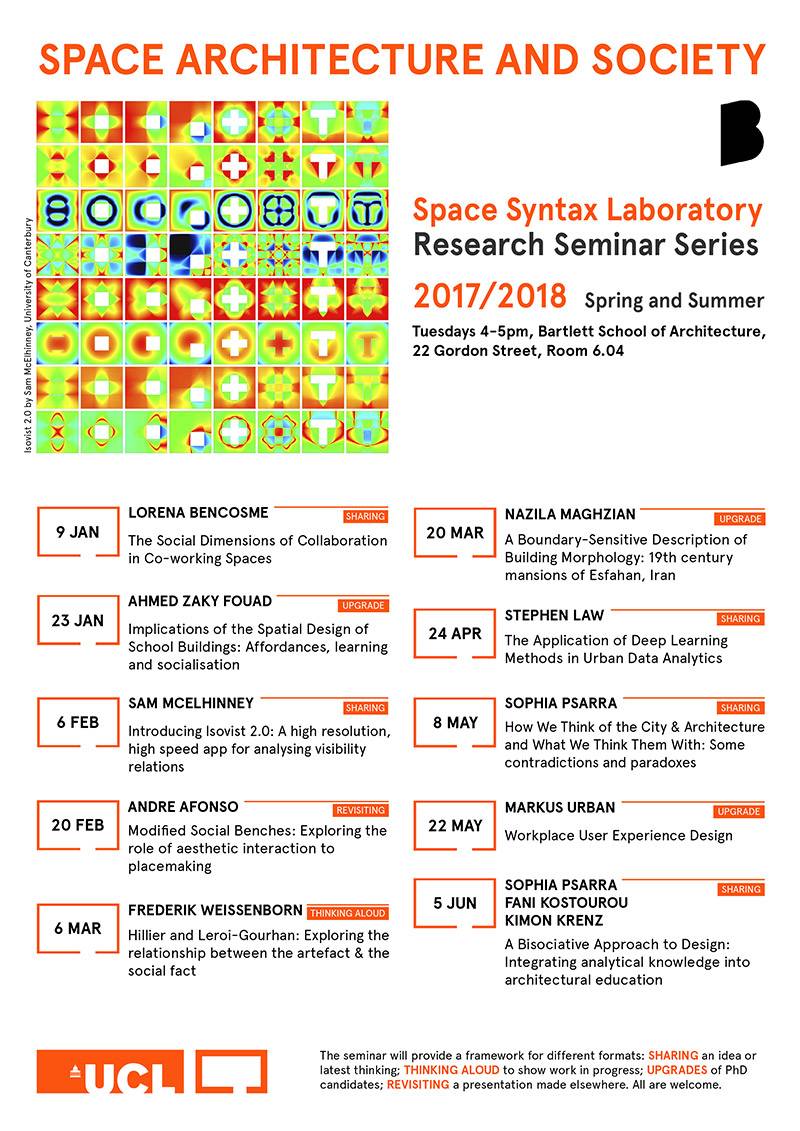Space Syntax Laboratory Research Seminar Series 2017/18
05 June 2018–12 June 2018, 4:00 pm–5:00 pm
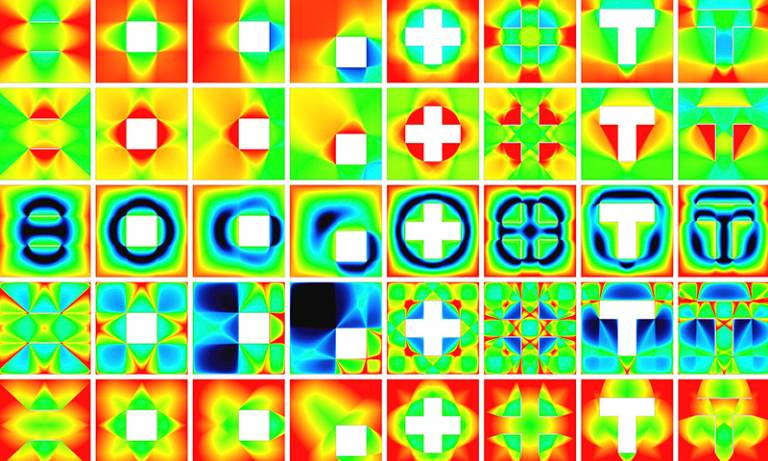
Fortnightly seminars showcasing the latest research conducted by the Space Syntax Laboratory
Event Information
Open to
- All
Availability
- Yes
Organiser
-
Space Syntax Laboratory02031087337
Location
-
5.04Gordon StreetLondonWC1H 0QBUnited Kingdom
This academic seminar series will include researchers sharing their findings, discussing their ideas and showing work in progress from The Bartlett's internationally renowned Space Syntax Laboratory.
The Seminars
- 9 January
Lorena Bencosme: The social dimensions of collaboration in co-working spaces The social dimensions of collaboration in co-working spaces
Tuesday 9 January, 16:00
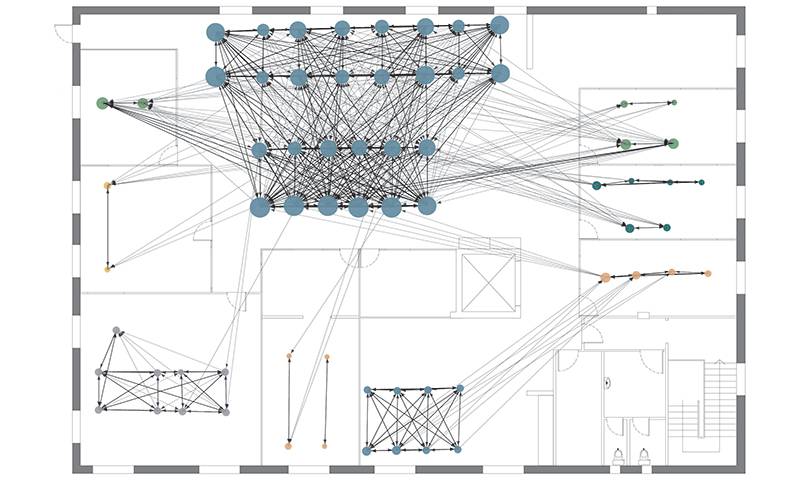
Abstract:
By systematically observing human behaviour in space and performing analytical models of it, this research investigates the social dimensions of collaboration: awareness, interaction, and actual collaboration. Through the study of a co-working space in London, it questions the potential of this type of work environment to facilitate professional collaboration between independent yet co-located workers.The research reveals unexpected interactive behavioural patterns which are empirically demonstrated to occur to a higher degree in secluded spaces. Additionally, it shows differential affordances for interaction and collaboration from desk locations.
The main contribution of this research is the development of a methodological framework for the study of co-working spaces by combining space syntax with social networks analysis (SNA), a joining of methods that is proven to be particularly insightful for the representation and analysis of spatial data in office environments. The work challenges the idea of integration as a driver for interaction and raises new questions for the social and syntactic study of complex buildings.
Lorena presents research conducted for her Master’s dissertation in Spatial Design: Architecture and Cities MSc, which has been awarded the Alasdair Turner Prize for best dissertation in 2017.
- 23 January
Ahmed Zaky Fouad: Implications of the spatial design of school buildings Implications of the spatial design of school buildings: affordances, learning and socialisation
Tuesday 23 January, 16:00
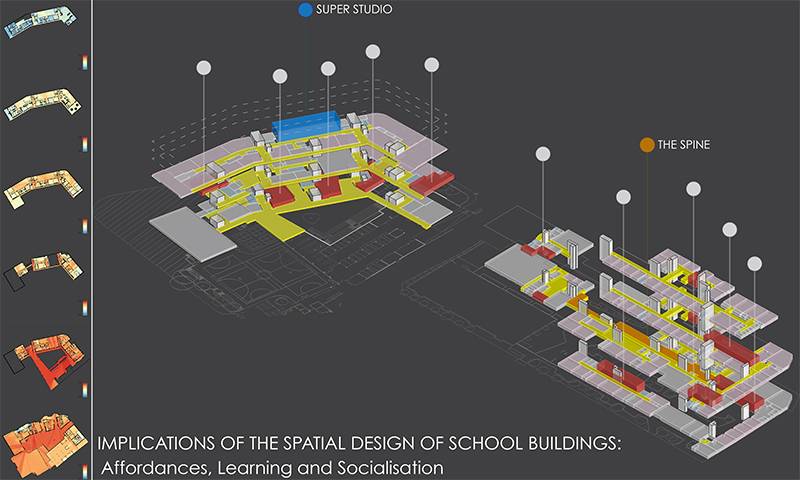
Abstract:
This research investigates the relation between spatial design (the physical environment) and learning (a mental process) in the context of school buildings. The key linkage between learning and space is the concept of ‘spatial affordances’. It is defined as the set of possibilities offered by the built environment (spatial design) for functions (actions) performed by the users (students).
Ahmed's research focuses on exploring the spatial affordances of ‘informal learning spaces’ for ‘self-directed learning’, i.e. students taking initiatives to construct their own knowledge. It is argued that learning as a mental process could take place in all the school spaces, wherever there is students’ social interaction. Accordingly, informal learning spaces are presented as spaces outside the classroom; assembly spaces, dining areas and circulation corridors.
The pilot study presented as part of this PhD upgrade provides a spatial comparison between two public secondary schools in London by exploring the design processes and the spatial configurations of the school buildings. This contributes to identifying the potential of spatial affordances for students’ self-directed learning within informal learning spaces. If the results were compared against the actual situation inside school buildings, the research could provide design guidelines for the future planning of informal learning spaces inside school buildings.
- 6 February
Sam McElhinney: Introducing Isovist 2.0 Introducing Isovist 2.0: A high resolution, high speed app for analysing visibility relations
Tuesday 6 February, 16:00
Followed by a special guest lecture by Prof John S. Gero at 17:15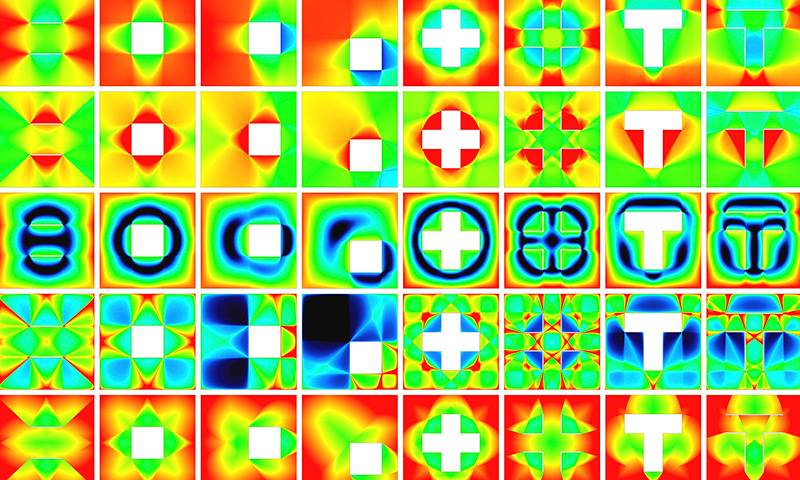
Abstract:
Isovist_2.0 is a free multi-platform software tool. It performs visibility analysis ‘scans’, that assist architectural practitioners and researchers in better understanding spatial coherence and structure within the built environment. It can be operated at any scale, from individual rooms to urban street patterns.The tool uses the spatial unit of the ‘isovist’ (Benedikt, 1979) to extract metrics of geometry and inter-visibility without requiring computationally lengthy graph analysis. The resulting ‘scans’ – output as coloured plan diagrams and quantitative point data – allow researchers or practitioners to intuitively and empirically identify experientially, navigationally or socially significant affordances within existing or proposed spatial environments.
During his seminar, Sam will outline inherent limitations that current visibility analysis techniques face and historic attempts to resolve these. Sam will also explain how the isovist, as a unit of embodied vision, can help to illuminate actualised and virtually embedded possibilities, rather than simply describing static spatial structures.
The lecture will define and demonstrate a series of ‘visibility layering’ variations, briefly summarise their various local and global qualities and discuss the potential of these for informing wider architectural design, spatial affordances, and interaction analysis. Finally, a live, real-time cross-comparison of spatial plan metrics will be used to speculate upon an as yet unrealised set of descriptors for architectural-spatial elements such as thresholds, enfilades, and so forth.
- 6 February
Prof John S. Gero: Social computing models of design creativity
(Guest Lecture) Social computing models of design creativity
Tuesday 6 February, 17:15
Room G.12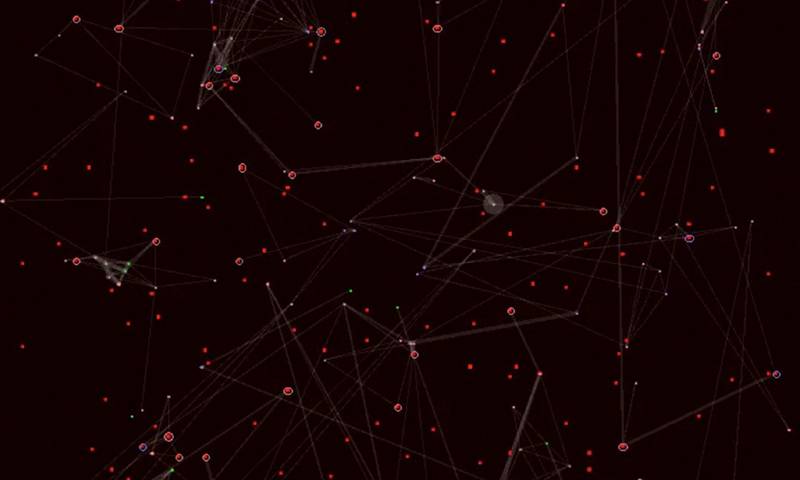
Abstract:
This talk will first outline a process-based framework for creativity before introducing the foundational concepts of situated cognition as a basis for social computing models of creativity. The situated cognition concepts are grouped under the following headings:- Social interaction
- Constructive memory
- Stigmergy
- Situatedness
In this lecture, two implemented social computing models of creativity will be presented. The first implementation demonstrates the behavior of a social, situated, curious agent-based model that generates products within an ecology of other producers. This results in emergent social structures that influence the creativity of producers.
The second implementation demonstrates how the value systems that consumers use to evaluate products as innovative evolve as they interact with product representations and with other consumers. This lecture will therefore present:
- Concepts of situated cognition as a basis for designing social computational agents
- Results from a study of creative behavior in a social setting
- Results from a study of innovation through consumer social behaviour
The talk will conclude by relating these computational models to Schumpeter’s concept of 'creative destruction'.
For more information, including Professor John S. Gero's biography, please visit this special lecture's event page.
- 20 February
Andre Alfonso: Exploring the role of aesthetic interaction to placemaking
(Media Architecture Research | Architectural Computation) Modified Social Benches: Exploring the role of aesthetic interaction to placemaking
Media Architecture Research | Architectural Computation
Tuesday 20 February, 16:00
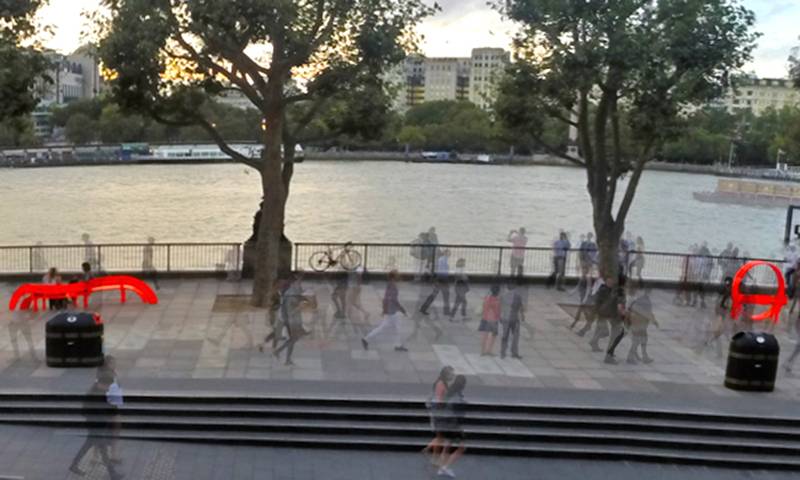
This presentation takes aesthetic interaction as a conceptual framework to analyse the Modified Social Benches, a set of urban art installations designed by Jeppe Hein. The discussion is based on a case study of the benches, and aims to clarify the role of aesthetic interactions in encouraging various forms of social encounters that characterise a lively urban place.
The study investigates the main social roles observed around the installations and identifies the most salient aspects regarding the bodily, spatial and experiential qualities of the interactions with the Modified Social Benches.
Expanding the field of aesthetic interactions to the urban scale may provide us with important tools and ideas on placemaking. The art installations presented here – affording unusual and playful forms of bodily and social encounters – serve as inspiring examples.
- 20 March
Nazila Maghzian: A boundary-sensitive description of building morphology A boundary-sensitive description of building morphology: nineteenth-century mansions of Esfahan, Iran
Tuesday 20 March, 16:00
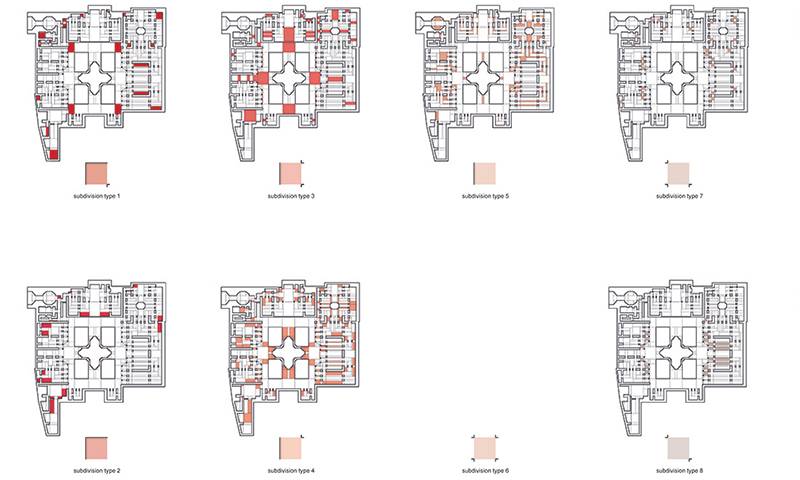
This study develops an analytical description of the morphology of orthogonal layouts. It explores how a morphological language can be characterised using local boundary properties of interior space. It proposes a method of convex partitioning that captures the relationship between space and its boundary. This happens through the notion of boundary-sensitivity. A convex partitioning is defined as boundary-sensitive if it satisfies three conditions:
Firstly, each convex space is defined by some boundary definition (at least a vertex). Secondly, a convex subdivision is defined by orthogonal sides. Thirdly, the sides of a convex subdivision is either defined by a solid boundary or is fully permeable to the adjacent space.In this study, a convex break-up satisfying the three conditions of boundary-sensitivity is constructed. The result is a convex partition that breaks up any orthogonal layout into the maximum of twelve types of convex subdivisions.
In this study, a sample of nineteenth-century mansions of Esfahan, Iran is used. The reason for this is that these mansions belong to a clear morphological system. The morphology of these mansions may have emergent origins with clear climatic and cultural concerns. However, at the peak of their development in the nineteenth century, they have developed into a clear formal language with variations for flexibility and adaptability. Using the proposed Boundary-based Partition, the selected mansions are studied in terms of the relation between their convex subdivisions and their boundaries, the values of integration, connectivity, and their area. The aim of these analyses is to explore whether there are any morphological patterns in the relation between boundary and space in the nineteenth-century mansions of Esfahan.
Please note that this is not a PhD upgrade seminar as labelled on the series poster.
- 24 April
Stephen Law: Applying deep convolutional neural networks in urban data analytics Applying deep convolutional neural networks in urban data analytics
Tuesday 24 April, 16:00
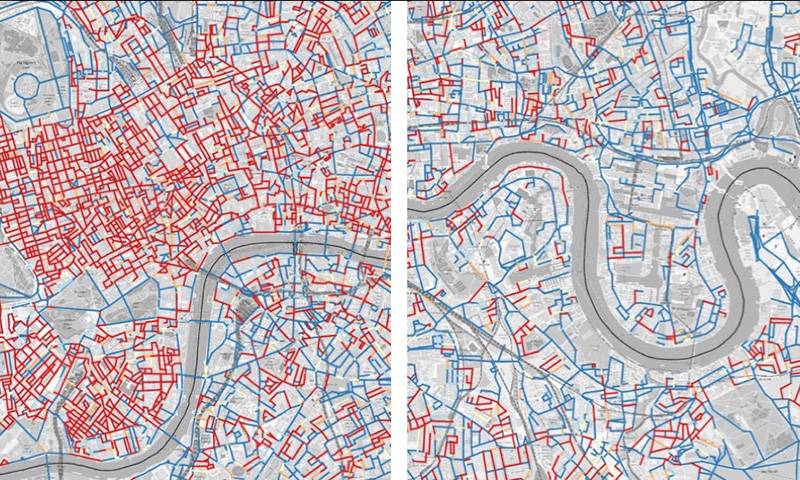
Deep convolutional neural networks are a class of artificial neural networks that have been successfully applied to various machine vision tasks such as object recognition, detection and segmentation. These techniques are now widely applied in disciplines such as robotics, medical imaging and intelligent transportation.
Despite these methodological advances and the ubiquity of large-scale urban image data, there has been limited research on the use of convolutional neural networks in urban data analytics.
This seminar presents two case-study applications. The first concerns the use of convolutional neural network methods in street-level geographical knowledge discovery. The second concerns the use of a learning model in auto-retrieving visual features of street images for hedonic price modelling.
- 8 May
Sophia Psarra: How we think of the city and architecture How we think of the city and architecture and what do we use to think of them: worldmaking in the expanded field
Tuesday 8 May, 16:00

Architecture is often defined by the humanistic idea of authorship and the individual creativity of the designer. In contrast, the large body of buildings and cities where social life takes place is considered as the collective outcome of socio-economic processes. This difference separates the social purpose of individual architectural works from the collective architectural and urban production, fragmenting architecture into different fields of knowledge.
One side of the debate sees architecture as liberal art, the other as part of the scientific paradigm and method. The opposition of individual and collective production contains a second dichotomy: that of the ‘built environment’, consisting of existing buildings and cities, versus design as a domain of possible configurations and hypothetical structures.
In this seminar I will address the theoretical questions behind these binaries: Is architectural knowledge a matter of socio-economic aspects and concerns or of individual creativity? Where does architectural knowledge come from? Are architecture and the city defined by the creative imagination alone or by multiple external influences and factors? Using some examples from my latest work, I will propose an expanded view of architecture, the city and spatial morphology, opening up the original oppositions to multiple overlapping definitions of authorship and spatial production.
- 22 May
Markus Urban: Workplace user experience design Workplace user experience design
Tuesday 22 May, 16:00
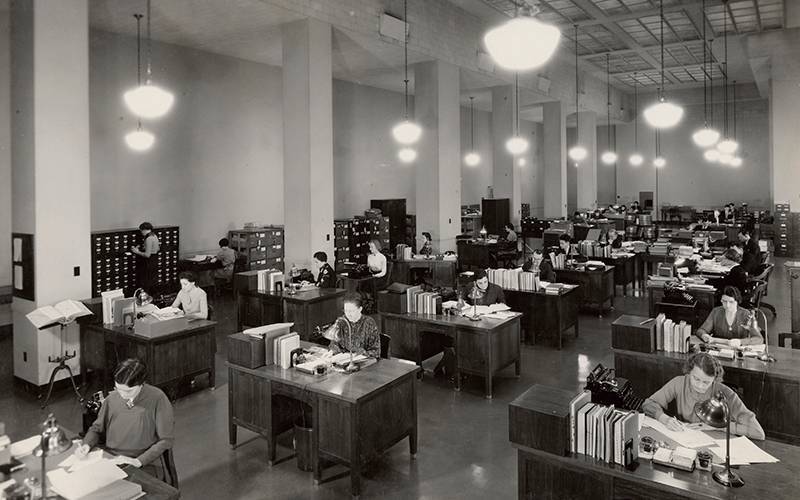
Within recent years the experience of people in workplace environments has become a core element in workplace design. An industry-wide paradigm shift sees businesses re-thinking solely targeting asset efficiency through the reduction of costs and the maximisation of productivity in order to focus on the user experience (UX) of workplaces. This paradigm shift is based on the assumption that great experiences attract people into businesses and keep them there – a crucial factor for business success.
Various disciplines such as business management, psychology and architecture began researching user experience in workplace environments – although from different angles. Since these different disciplines mostly focus on partial aspects of UX in workplace environments, they fail to capture the concept as a whole, since user experience is a holistic term and as such is influenced by various criteria. As a result, UX in workplace environments remains an unclear concept that is difficult to measure and take into account when designing.
Against this backdrop my PhD research aims to understand which criteria define user experience in workplace environments and how these criteria can be used to inform workplace design. In my PhD upgrade seminar, I will present and discuss my pilot study which is a qualitative study of UX in the workplace of an architectural practice. I will also outline the methodology and programme of my PhD. My research aims to provide an understandable and implementable framework as well as a standardised questionnaire to measure and compare user experience in workplace environments. Ultimately it is hoped that this research will enhance the understanding of UX in workplace environments and help design better workplaces.
- 5 June - new speaker
David Kirsh: Creativity enhanced by interactivity, abstraction and chance Creativity enhanced by using interactivity, abstraction and chance
Tuesday 5 June, 16:00
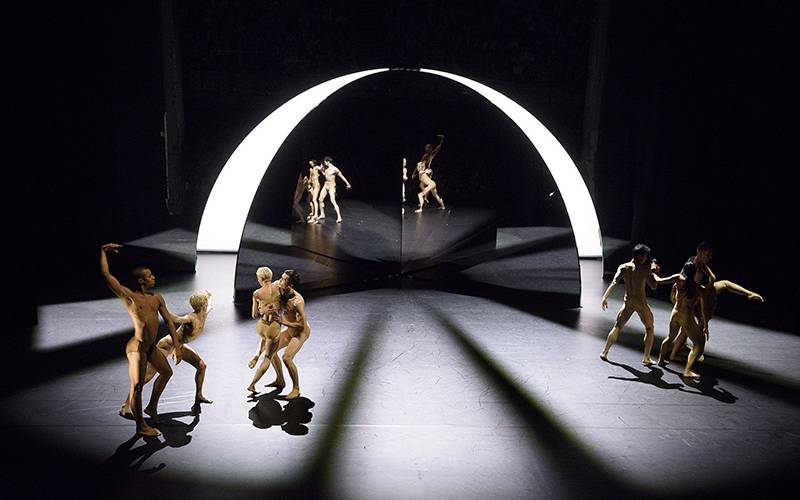
"How can I have a thought until I know what I want to think? If I already know it, why bother to articulate it, even in inner sound images? The obvious answer is ‘to see what I am going to say’. Somewhere there are subconscious forces driving thought or there are things we can do externally that stimulate thought whose results we can sense, then interpret and evaluate.
This process is typically interactive, dependent on the tools and resources we have; it often involves abstraction and it benefits from chance. I discuss these creativity-enhancing processes using examples from choreography, architecture and science to show how interacting with tools and nearby objects or events shape thought."
Biography:
David Kirsh is Professor and past Chair of the Department of Cognitive Science at University California, San Diego (UCSD), where he runs the Interactive Cognition Lab.
- 12 June
Frederik Weissenborn: The relationship between the artefact and the social fact Hillier and Leroi-Gourhan: Exploring the relationship between the artefact and the social fact
Tuesday 12 June, 16:00
Room change: Room 5.02, The BartlettThis seminar argues that Bill Hillier’s theory of society and space, which some scholars conceive as an extension of Emile Durkheim's sociological theory, is more adequately framed through the work of another thinker, the palaeontologist André Leroi-Gourhan. A towering figure in 20th century French intellectual life, Leroi-Gourhan tends to be less familiar to Anglo-Saxon readers who know him mainly as a scholar of cave paintings.
However, Leroi-Gourhan's most significant contribution is arguably not his work on prehistoric art, but his profound and intellectually stimulating exploration of the evolution of artifactual lineages and their complex relationship to transformations in human social behaviour. His is a true theory of artefact and social fact; a theory in which neither is granted theoretical primacy.
If this provides an apt reframing of Bill Hillier's theory of society and space, it is because space syntax, at its heart, constitutes a theory of how an artefact (urban form) and a social fact (urban social behaviour) relate to each other over time. The seminar will provide an introduction to the life and work of Leroi-Gourhan and use it to contextualise various concepts from Bill Hillier's work, including the notions of the genotype/phenotype and the fundamental city.
Lead image: Sam McIlhinney
 Close
Close


